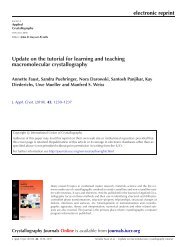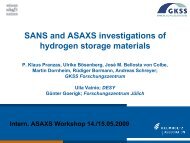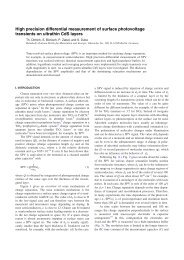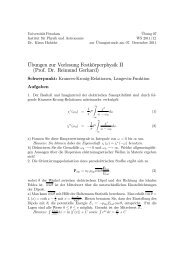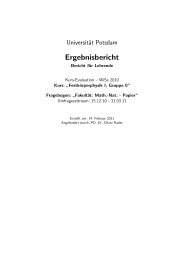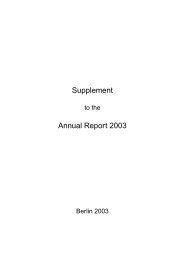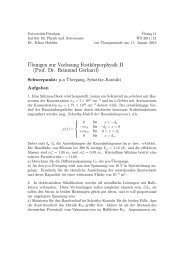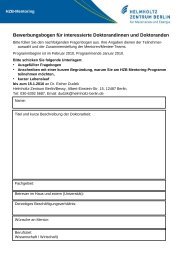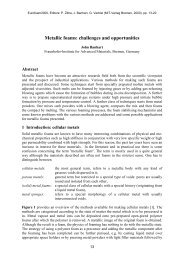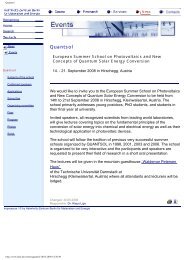XDSAPP - Helmholtz-Zentrum Berlin
XDSAPP - Helmholtz-Zentrum Berlin
XDSAPP - Helmholtz-Zentrum Berlin
Create successful ePaper yourself
Turn your PDF publications into a flip-book with our unique Google optimized e-Paper software.
Table 1<br />
Data collection and processing statistics of case study 1.<br />
Data set Insulin <strong>XDSAPP</strong> Insulin manual<br />
Wavelength (A˚ ) 1.77<br />
Crystal–detector distance (mm) 50<br />
Rotation range per image ( ) 1.0<br />
Total rotation range ( ) 180<br />
Exposure time per image (s) 2.4<br />
Space group<br />
Resolution range (outer range) (A<br />
I23 or I213<br />
˚ ) 50.0–1.55 (1.65–1.55) 50.0–1.55 (1.65–1.55)<br />
Unit-cell parameters<br />
a, b, c, , , (A˚ , )<br />
78.08, 78.08, 78.08,<br />
90.0, 90.0, 90.0<br />
78.07, 78.07, 78.07,<br />
90.0, 90.0, 90.0<br />
Mosaicity ( ) 0.098 0.108<br />
Total No. of reflections 215 318 179 837<br />
Unique reflections 22 106 22 057<br />
Multiplicity 9.74 8.15<br />
hI/ (I )i 44.7 (8.26) 42.2 (9.1)<br />
ISa 26.98 27.36<br />
Completeness (%) 99.4 (96.5) 99.1 (94.6)<br />
Rmerge† (%) 3.9 (24.1) 3.2 (14.9)<br />
Rmeas/Rr.i.m.† (%) 4.0 (25.6) 3.4 (16.8)<br />
Rp.i.m.† (%)<br />
Overall B factor from Wilson plot (A<br />
0.9 (8.2) 1.0 (5.5)<br />
˚ 2 ) 22.13 21.52<br />
† Rmerge ¼ P P<br />
hkl i jIiðhklÞ hIðhklÞij= P P<br />
hkl i IiðhklÞ, where IiðhklÞ is the integrated<br />
intensity of a given reflection and hIðhklÞi is the mean intensity of multiple corresponding<br />
symmetry-related reflections. Rmeas ¼ Rr:i:m: ¼ P hkl½N=ðN 1ÞŠ 1=2 P i jIiðhklÞ hIðhklÞij= P P<br />
hkl i IiðhklÞ, where N is the multiplicity of a given reflection.<br />
Rp:i:m: ¼ P hkl½1=ðN 1ÞŠ 1=2 P i jIiðhklÞ hIðhklÞij= P P<br />
hkl i IiðhklÞ. ISa = I/ (I )asymptotic<br />
represents the highest possible signal-to-noise ratio of a data set (Diederichs, 2010). Data<br />
sets with ISa values of 25 or greater are considered to be very good and should allow for<br />
straightforward structure determination. The calculation of ISa has been implemented in<br />
XDS since December 2009.<br />
Table 2<br />
Comparison of overall statistics after the first and the second integration step with<br />
refined parameters for the Tt-IPMDH data set (case study 2).<br />
No resolution cut-off was applied at that stage of processing.<br />
Integration 1 Integration 2<br />
hI/ (I )i 6.12 9.93<br />
Completeness (%) 88.1 92.7<br />
R meas or R r.i.m. (%) 20.4 13.7<br />
ISa 13.89 26.12<br />
<strong>XDSAPP</strong> displays the overall numbers of the twinning tests by<br />
SFCHECK and PHENIX.XTRIAGE and stores the complete output<br />
of these programs in log files within the processing directory.<br />
3.2. Case study 2<br />
The second case study is a data set of a Tt-IPMDH (isopropylmalate<br />
dehydrogenase from Thermus thermophilus) crystal. This data<br />
set consists of 720 diffraction images. In this case, frames 1–20 and<br />
350–370 were used to collect strong spots from. Owing to the<br />
comparatively poor quality of the diffraction images, the indexing<br />
turned out to be less accurate than in case study 1, which is reflected<br />
in a rather large standard deviation of the spot position of 5.66 pixels<br />
before and 1.22 pixels after refinement and quite big mean absolute<br />
differences between observed and fitted indices (DH = 0.03, DK =<br />
0.09, DL = 0.08). Consequently, the results of the first integration step<br />
were also unsatisfactory. Nevertheless, it turned out to be possible to<br />
improve the integration significantly by the second, automatically<br />
launched, integration step using the post-refined parameters<br />
(Table 2). For example, the value of ISa (Diederichs, 2010) almost<br />
doubled from integration step 1 to integration step 2. As can be seen<br />
from the numbers presented in Table 3, <strong>XDSAPP</strong> processed the data<br />
set to slightly lower resolution than in the manual processing. This is a<br />
consequence of the default parameters for resolution cut-off in the<br />
Table 3<br />
Data collection and processing statistics of case study 2.<br />
computer programs<br />
Data set Tt-IPMDH <strong>XDSAPP</strong> Tt-IPMDH Manual<br />
Wavelength (A˚ ) 0.91841<br />
Crystal–detector distance (mm) 301.42<br />
Rotation range per image ( ) 0.25<br />
Total rotation range ( ) 150<br />
Exposure time per image (s) 4.0<br />
Space group<br />
Resolution range (outer range) (A<br />
C2221 or C222<br />
˚ ) 50.0–2.94 (3.12–2.94) 50.0–2.8 (2.97–2.80)<br />
Unit-cell parameters<br />
a, b, c, , , (A˚ , )<br />
51.33 153.69 176.48,<br />
90, 90, 90<br />
51.31 153.68 176.41,<br />
90, 90, 90<br />
Mosaicity ( ) 0.166 0.145<br />
Total No. of reflections 92 765 128 591<br />
Unique reflections 15 175 17 657<br />
Multiplicity 6.11 7.28<br />
hI/ (I )i 20.2 (3.2) 19.4 (2.0)<br />
ISa 27.86 28.71<br />
Completeness (%) 99.3 (98.3) 99.6 (98.5)<br />
Rmerge† (%) 6.6 (51.3) 7.6 (90.2)<br />
Rmeas/Rr.i.m.† (%) 7.2 (52.7) 8.2 (97.0)<br />
Rp.i.m.† (%)<br />
Overall B factor from Wilson plot (A<br />
2.9 (21.8) 3.0 (36.1)<br />
˚ 2 ) 70.55 74.58<br />
† See Table 1 for definitions of the used metrics.<br />
‘Settings’ tab. For this data set, no twinning or pseudo-translation was<br />
identified by SFCHECK and PHENIX.XTRIAGE.<br />
The plot of Rmeas/Rr.i.m. per frame of Fig. 4(b) shows that the quality<br />
of this data set is almost constant over the whole data range, i.e. there<br />
are no parts of noticeably bad quality. The plot of RD as a function of<br />
frame difference in Fig. 4(b) shows almost no increase with increasing<br />
frame difference. This indicates that there are no significant signs of<br />
radiation damage present within this data set.<br />
4. Conclusion<br />
<strong>XDSAPP</strong> is a GUI that significantly simplifies diffraction data<br />
processing with XDS. It can give novice users who are deterred by the<br />
command line input to XDS comprehensible access to this software.<br />
The visualization of tables of statistics as plots within the GUI<br />
simplifies the validation of the results.<br />
The two case studies showed that <strong>XDSAPP</strong> is able to process<br />
diffraction data sets as well or almost as well as conventional manual<br />
processing. In particular, case study 2 showed that even a data set that<br />
could not be accurately indexed can be processed reliably. In this<br />
case, the automatically launched second integration step with postrefined<br />
parameters leads to a significant improvement of the results<br />
without any manual user interference.<br />
The plots visualizing information generated by XDSSTAT can<br />
help to facilitate decision making of manual fine-tuning steps to<br />
further improve data quality.<br />
The summarized results of the intensity evaluations carried out by<br />
SFCHECK and PHENIX.XTRIAGE can give a quick warning of<br />
special crystallographic cases and can help to identify, for example,<br />
the one untwinned crystal amongst many.<br />
<strong>XDSAPP</strong> will be made available, free of charge for academic users,<br />
upon request and after registration from the web page http://<br />
www.helmholtz-berlin.de/bessy-mx.<br />
We gratefully acknowledge the support of the Joint <strong>Berlin</strong> MX<br />
Laboratory, which made this work possible. We would also like to<br />
thank Dr Kay Diederichs (University of Konstanz, Germany) for<br />
initiating this project and for comments on the manuscript and Dr<br />
Anna Pallo (Chemical Research Center, Hungarian Academy of<br />
J. Appl. Cryst. (2012). 45, 568–572 Michael Krug et al. <strong>XDSAPP</strong> 571<br />
electronic reprint




